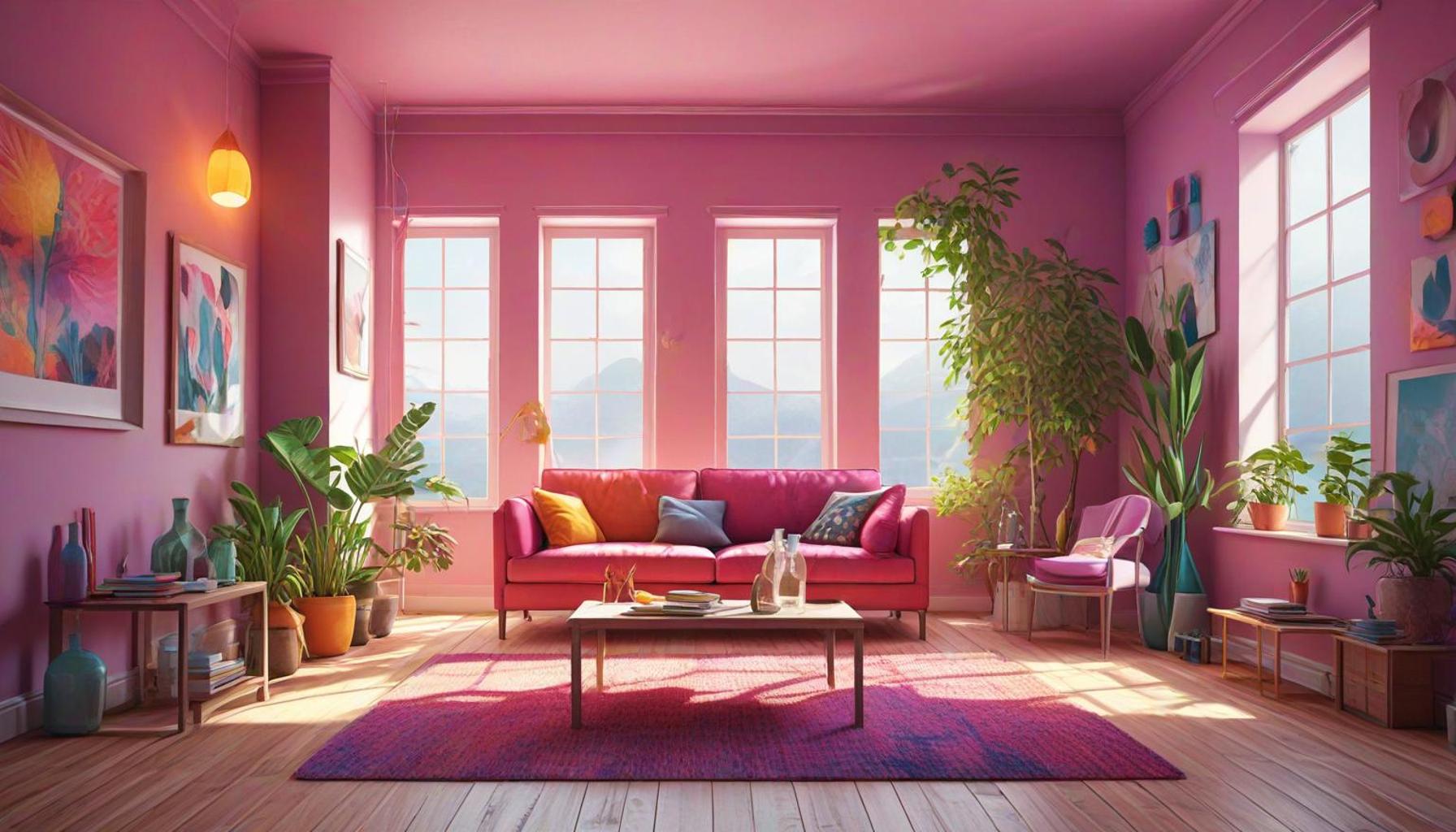Mindful Living: Strategies for Creating Spaces that Promote Calm and Mental Clarity

Understanding Mindful Living
In our fast-paced world, the importance of creating a tranquil environment is paramount. Mindful living encourages us to design spaces that foster calm and enhance our mental clarity. Research indicates that our surroundings heavily influence our emotional and mental states, which is why cultivating environments that promote serenity is crucial for managing stress and improving our overall well-being.
Essential Elements of Mindful Living
Consider incorporating several essential elements into your environment to promote mindful living and tranquility:
- Natural Light: The magical glow of sunlight can significantly uplift your mood and enhance productivity. Studies have shown that exposure to natural light not only helps regulate our circadian rhythms but also boosts serotonin levels, leading to increased feelings of happiness. Try positioning your workspace or reading nook near a window or consider utilizing lighter shades for window treatments to maximize daylight.
- Minimalism: A clutter-free space minimizes distractions and cultivates a sense of peace. The principle of minimalism revolves around keeping only what you truly need or love while eliminating excess items that crowd your space and mind. This approach can be particularly appealing in urban areas where space is limited. By adopting a minimalist mindset, you can create environments that encourage conscious living, focusing on what truly matters.
- Natural Materials: Incorporating elements like wood, stone, or plants can create a deeper connection to nature, promoting serenity. Indoor plants, such as succulents or peace lilies, not only purify the air but also serve as a vibrant reminder of nature’s beauty. Natural wood furniture can add warmth and authenticity to your space. These organic materials contribute to a calming atmosphere that soothes the senses.
Roots of Mindful Design
These strategies are not merely aesthetic trends; they are grounded in extensive research underscoring the significant impact of our environments on mental wellness. For instance, architectural studies have demonstrated that available natural light can enhance cognitive function and overall mood. Similarly, cluttered environments can provoke feelings of anxiety and stress, highlighting the importance of intentional design.
As we delve into the various aspects of mindful living, you’ll discover innovative strategies that can be tailored to fit any home or workspace. From simple adjustments—like rearranging furniture for better flow—to intentional design choices—such as selecting serene color palettes—these ideas aim to enhance your quality of life.
Conclusion: A Journey Towards Tranquility
Are you ready to explore how creating calm spaces can lead to greater mental clarity? Embracing mindful living is a journey that can transform everyday environments into sanctuaries of peace and tranquility. Whether you are at home, in your workplace, or anywhere in between, taking steps toward a more mindful existence promises numerous benefits for both your mind and spirit. Let’s embark on this enlightening journey together, one serene space at a time.

DISCOVER MORE: Click here to learn how essentialism can transform your productivity
Creating a Mindful Atmosphere
To fully embrace the essence of mindful living, it is essential to consider how our environments can resonate with tranquility and clarity. A thoughtfully curated space not only encourages relaxation but also empowers us to maintain focus amidst the chaos of everyday life. Below are strategic approaches to cultivating such mindful atmospheres:
- Color Psychology: The choice of color in your space plays a pivotal role in establishing a calming ambiance. Soft hues like blues, greens, and neutrals are often associated with tranquility. For instance, painting a room in a gentle shade of blue can evoke feelings of serenity, while greens bring to mind a sense of rejuvenation reminiscent of nature. Avoid bold or overly stimulating colors that can provoke anxiety and restlessness. Instead, opt for a serene palette that promotes mental clarity.
- Soundscapes: The sounds that surround us can have profound effects on our mental state. Consider introducing soothing soundscapes into your environment—such as gentle music, nature sounds, or even white noise machines. These auditory elements can mask disruptive noises, helping to create a serene backdrop for productivity or relaxation. Experimenting with sound can facilitate a more peaceful environment conducive to mindfulness.
- Intentional Layout: The arrangement of furniture and decor can significantly influence the flow of energy within a space. Aim to create open pathways that encourage movement and interaction without obstruction. For example, placing your desk near windows can enhance natural light exposure while providing a view of nature, both of which are beneficial for concentration. By being intentional with your layout, you can promote a sense of ease and accessibility throughout your home or workspace.
- Sensory Elements: Incorporate sensory elements that engage the senses and invite tranquility. This might include soft textiles like plush throws or cushions, fragrant candles with calming scents such as lavender or chamomile, and art pieces that resonate with positive emotions. By engaging all senses, you create an immersive environment that supports mindfulness.
The Impact of Mindful Environments
Research supports that our environments are not just backdrops to our lives; they actively shape our experiences. Psychologists emphasize that spaces designed for mindful living can reduce stress levels, enhance concentration, and promote overall well-being. For example, a study published in the journal Environmental Psychology highlights that individuals working in spaces filled with natural elements—like plants or sunlight—show increased productivity and are less prone to burnout.
Exploring mindful living extends beyond aesthetic choices; it invites us to fundamentally rethink how we interact with our environments. Adjusting our surroundings to favor calmness and clarity can be a powerful tool in cultivating a healthier lifestyle. As we traverse through these mindful strategies, consider how each recommendation aligns with your personal values and lifestyle, creating a unique sanctuary that serves as a foundation for peace of mind.
Strategies for Mindful Living
Embracing mindful living begins with intentionality in how we design and organize our spaces. The physical environment we inhabit can significantly impact our mental state and overall wellness. When creating spaces that promote calm and mental clarity, the following strategies can be pivotal:
1. Optimize Natural Light
Natural light has a profound effect on our mood and productivity. Ensure your space maximizes sunlight by keeping windows unobstructed and using light, airy curtains. As the sun’s rays illuminate a room, they can enhance feelings of brightness and positivity, contributing to a serene atmosphere.
2. Incorporate Natural Elements
Bringing the outdoors inside can foster a stronger connection to nature, which is proven to lower stress and enhance tranquility. Utilize plants, natural materials, and organic textures in your decor. For example, indoor plants not only purify the air but also serve as a living reminder of the beauty and calm found in nature.
3. Create Designated Zones
Different areas within your space can serve distinct purposes. Establish zones for relaxation, reading, meditation, or activities that require focus. Each zone should be distinctly designed to cater to its purpose. For instance, a cozy reading nook with comfortable seating and soft lighting can be perfect for unwinding.
4. Declutter Regularly
A cluttered environment can lead to a cluttered mind. Regularly evaluate your belongings and remove items that no longer serve a purpose or bring you joy. Keeping a tidy space can enhance mental clarity and promote a sense of calm. Adopt minimalist principles to create a more soothing atmosphere.
5. Utilize Calming Colors
Color psychology plays a crucial role in influencing feelings and emotions. Consider using calming hues such as soft blues, greens, and neutrals in your space. These colors can evoke a sense of peace and relaxation, making it easier to achieve a tranquil state of mind.
By incorporating these mindful strategies into your life and environment, you can create a sanctuary that nurtures mental clarity and emotional well-being.
| Category | Advantages |
|---|---|
| Natural Light | Boosts mood and productivity by enhancing positivity. |
| Natural Elements | Lowers stress levels and connects you to nature’s tranquility. |
| Designated Zones | Promotes focus and relaxation through intentional space usage. |
| Decluttering | Promotes mental clarity while enhancing the calming environment. |
| Calming Colors | Elicits feelings of peace and relaxation, aiding in mindfulness. |
By implementing these essential practices, anyone can transform their surroundings into a haven of peace, enabling a more mindful approach to daily life. Delve deeper into the elements that enhance your living space to fully experience the benefits of mindful living.
DISCOVER MORE: Click here for practical steps to a clutter-free home
Natural Elements: Bringing the Outdoors In
The integration of nature into our living spaces has profound implications for enhancing our sense of well-being and mental clarity. Research has shown that incorporating natural elements—both visually and physically—can contribute significantly to a more mindful living environment. One effective strategy is the inclusion of indoor plants, which not only purify the air but also create a connection to the natural world, thereby fostering tranquility.
- Biophilic Design: This design approach prioritizes natural elements, aiming to reconnect with the earth. Elements such as natural wood finishes, stone accents, and large windows that invite sunlight can cultivate a sense of peace. Biophilic designs often include varied textures and shapes that reflect nature’s diversity, helping to reduce stress and improve overall mood.
- Outdoor Spaces: If circumstances allow, think about incorporating an outdoor element to your mindful environment—like a meditation garden or a small patio with plants. Research indicates that spending time outdoors helps reduce cortisol levels, making it an ideal setting for mindfulness practices. Even having a small balcony with plants or flowers can offer a refreshing escape that promotes relaxation and mental clarity.
- Natural Light: The importance of natural light cannot be overstated. Exposure to daylight can bolster mood and enhance concentration. Strategically positioning mirrors to reflect light or using sheer window treatments to maximize daylight can brighten your space and elevate your mental state. Additionally, consider integrating light sources that mimic the sun’s natural spectrum to maintain a vibrant atmosphere even on overcast days.
Decluttering for Mental Clarity
A key aspect of creating a mindful space is the practice of decluttering. When our spaces are overwhelmed by unnecessary items, they can lead to cognitive overload and anxiety. A minimalistic approach helps foster a sense of clarity, letting the mind breathe.
- Intentional Organization: Curate your space by thoughtfully deciding which items truly elevate your experience. Foster interactions with objects that hold positive memories or serve a clear purpose, setting aside those that no longer contribute to your well-being. Utilize storage solutions that keep items organized yet accessible, avoiding the appearance of chaos.
- The One-Year Rule: A helpful method for effective decluttering is the one-year rule: if you haven’t used an item in the past year, consider letting it go. This practice promotes mindful decision-making and facilitates a continuous evolution of your space that aligns with your current lifestyle.
- Framing Views: Once decluttered, consider how the remaining elements in your space can serve as focal points. Strategically placing art or decor that inspires calmness can redirect your focus away from stressors. Visual priorities within your space create a guided experience, steering attention towards positive thoughts and encouraging a mindful mindset.
Mindfulness in Daily Routines
Finally, remember that mindfulness is not merely a destination but a journey. Integrating mindful practices into daily routines can significantly enhance how you experience your environment. Simple acts like practicing gratitude upon waking, arranging flowers while meditating, or engaging in mindful eating during meals can help reinforce the calm within your curated spaces.
By intentionally cultivating environments that resonate with tranquility, engaging with natural elements, maintaining organization, and incorporating mindfulness into your daily lives, you can construct a sanctuary that promotes both mental clarity and serenity. Each mindful choice shapes your experience and redefines how you interact with the world around you, forming a continuous pathway toward inner peace and well-being.
DISCOVER MORE: Click here to unlock the psychological benefits of decluttering
Conclusion: Embracing Mindful Living for a Harmonious Environment
In a world that often feels chaotic, creating spaces that promote calm and mental clarity is not just a luxury; it is a necessity for our well-being. By exploring mindful living strategies such as integrating natural elements, decluttering, and incorporating mindful practices into our daily routines, we can craft environments that support our mental health. The power of biophilic design reminds us of our connection to nature, enhancing tranquility and promoting a clearer mindset. Furthermore, the act of decluttering not only simplifies our physical space but also liberates our minds, allowing for a more focused and peaceful existence.
Ultimately, by being intentional about our surroundings—choosing decor that inspires, utilizing natural light effectively, and embracing the one-year rule for decluttering—we can design homes that serve as sanctuaries for reflection and relaxation. Mindfulness, too, is a continuous practice; daily rituals can anchor us in the present moment and deepen our appreciation for our curated spaces.
As you embark on this journey of crafting a mindful environment, consider each choice as a step toward improved mental clarity and emotional balance. By fostering spaces that resonate with serenity, we not only transform our homes but also our inner landscapes. The journey to a mindful life is a profound exploration that can lead to a more harmonious existence, one peaceful space at a time.



